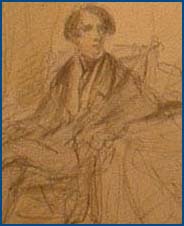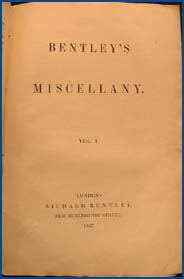|
When Is a Book Not a Book? Oliver Twist in Context Section 1. Periodical Publishing and Book HistoryWithin a print culture, many forms of communication are not constructed for or produced in book format. Private letters, state documents, manuscript poetry circulated within a coterie as John Donne's poetry was, and dramatic scripts are some instances of writing not designed for book publication. Another nonbook publication format is the periodical. The fictions issued in nineteenth-century magazines and newspapers provide complex and interesting cases where privileging the volume edition over the periodical issue distorts the nature of the fiction and the history of the book. These cases are important exceptions to the primacy of book publication throughout the century, for, as eminent literary historian George Saintsbury has said, "there is no single feature of the English literary history of the nineteenth century ... which is so distinctive and characteristic as the development in it of periodical literature." What is a book? According to the Oxford English Dictionary, a book is a "printed treatise or series of treatises, occupying several sheets of paper or other substance fastened together so as to compose a material whole." Books are sheets of paper on which something self-contained and internally coherent has been printed; all the printed material relates in some way to the book's title and "treatise." The contents of books are fixed in space—"fastened together so as to compose a material whole"—and they are also fixed in time, since the Renaissance, to a date at which copyright protection commences. Finally, many books are defined by being authored, or edited, by one or more than one person. Indeed, marketing a book by the author's name has been a commercial strategy for centuries: Stephen King's and Barbara Cartland's names are more important than the titles of their newest productions. When, around 1700, magazines were invented in England, the designers started out by creating a character, a persona, whose observations constituted the "printed treatise" of the publication. Thus Richard Steele produced Isaac Bickerstaff, a principal correspondent for The Tatler (1709-11), and Steele with his fellow editor Joseph Addison developed the persona of "Mr. Spectator" for The Spectator (1711-12, 1714). In 1731, the first periodical with the word "magazine" in the title appeared; its persona was also announced in the title, Gentleman's Magazine. A century later, the proprietors and editors of Punch created Mr. Punch, who never quite qualified as a gentleman. Magazines aim to develop their own distinctive personality; editors, designers, writers, and artists all direct their efforts toward that end. For instance, The New Yorker has a distinctive personality, complete with a character, Eustace Tilley, who on the cover published at the end of February every year examines a butterfly through his monocle. This magazine prints only certain kinds of prose and poetry and cartoons, only certain kinds of "Talk of the Town." Magazines, then, like books, often market themselves as coherent texts "fastened together so as to compose a material whole" and authored by an individual. But magazines are in other ways very different from books. To illustrate one aspect of the stake our society has in preferring the book to other publication formats, consider this entry in a recent bookseller's catalogue: "AN EXCEPTIONALLY FINE COPY. REMARKABLY CLEAN. DICKENS (Charles) Oliver Twist, ... 3 volumes, FIRST EDITION. First issue, ... choicely bound for Hatchards, ... £1500." This notice is misleading in fundamental ways. The "material whole" for sale for £1500 is not the first issue or first edition of most of the text of the novel now known as Oliver Twist . It does not print the title by which the story was first identified; it is not a book whose author was named Charles Dickens; and it is not even the same "material whole" the book was when it first appeared. This three-volume edition, authored by "Boz," was originally published by Richard Bentley in three volumes bound in cloth covers on November 9, 1838, six months before Oliver Twist finished its serialized run in the pages of Bentley's Miscellany. This bookseller's copy has been rebound in half red morocco with gilt tops and gilt letters: the cloth covers have been stripped off, leather covers substituted, the edges of the pages trimmed and the tops of the pages gilded to protect them from dust. So this is not "an exceptionally fine copy" of the first three-volume book edition of the novel, but rather a copy that has been made finer by an expensive bookbinder (unnamed) and book dealer (Hatchard's, on Piccadilly near London's Piccadilly Circus). This copy sells for £1500 because it is handsomely bound and because it contains early state title pages, a suppressed plate and three leaves of publishers' advertisements that have nothing to do with the text of the "treatise," that is, Oliver Twist.By contrast, battered copies of the monthly numbers or half-yearly volumes of Bentley's Miscellany containing the serialized version of Oliver Twist could, at least until recently, be found on bookstalls for a few pounds. And for a little over half the £1500 that would buy a single novel, booksellers have offered 28 volumes of Cornhill Magazine , 1860-73, whose first editor was William Makepeace Thackeray, Dickens's great rival as journalist and novelist. Within those 28 volumes are hundreds of stories and articles and the first issue of four serial fictions by Anthony Trollope, two by Thackeray, and one each by Elizabeth Gaskell, Wilkie Collins, and George Eliot. For even less money, $1200, an antiquarian bookseller recently offered 10 half-yearly volumes of Bentley's Miscellany, 1837-41, containing, as the dealer correctly says, " the true first version of Oliver Twist. " In addition, these 10 volumes contain a half-dozen other significant novels, scores of poems and articles, and over 100 first-issue etchings by George Cruikshank. But dealers, collectors, museums, libraries, bibliographers, textual scholars, and the general public have been conditioned to think of the book as the substantial, first publication of most serials, from Dickens's Pickwick Papers to Thomas Hardy's Tess of the d'Urbervilles and Joseph Conrad's Lord Jim. Books have authors who are solely responsible for their contents—Charles Dickens, for example, even though those "early state" title pages of the "exceptionally fine copy" of Oliver Twist identify the author not as Charles Dickens but as what was then a well-known pseudonym, "Boz." And books get passed down through the generations, while periodicals are tossed out by families or broken up for the prints by dealers or reduced to microfilm, -form, or -fiche by librarians. The book is semipermanent and simply displaces the format in which the text first appeared. This is true for virtually every magazine serial, not just fiction, but also history, theology, biography, philosophy, criticism, and other genres which, as Saintsbury reminds us, were often in the nineteenth century first published in installments in periodicals.Over the past 25 years, we have learned a lot about what this preference for the book produces in the way of copytext distortions. But this presentation is concerned not with the textual controversies surrounding serialized, machine-printed works, but with the distortions that our preference for the book version have imposed on our very conception of periodical fiction. Defining the text as an identifiably authored and self-contained book obscures the ways fictions were affected by the periodicals in which they first appeared. Sections 2-5 of this presentation address the four aspects of book fiction that are significantly altered by magazine serialization: the convention of single authorship, the genre of fiction itself, the closed boundaries of the "material whole," and the timing and effect of the story's reception.
|

